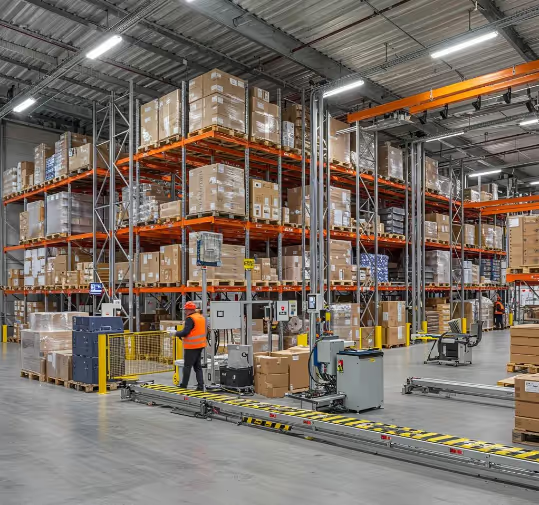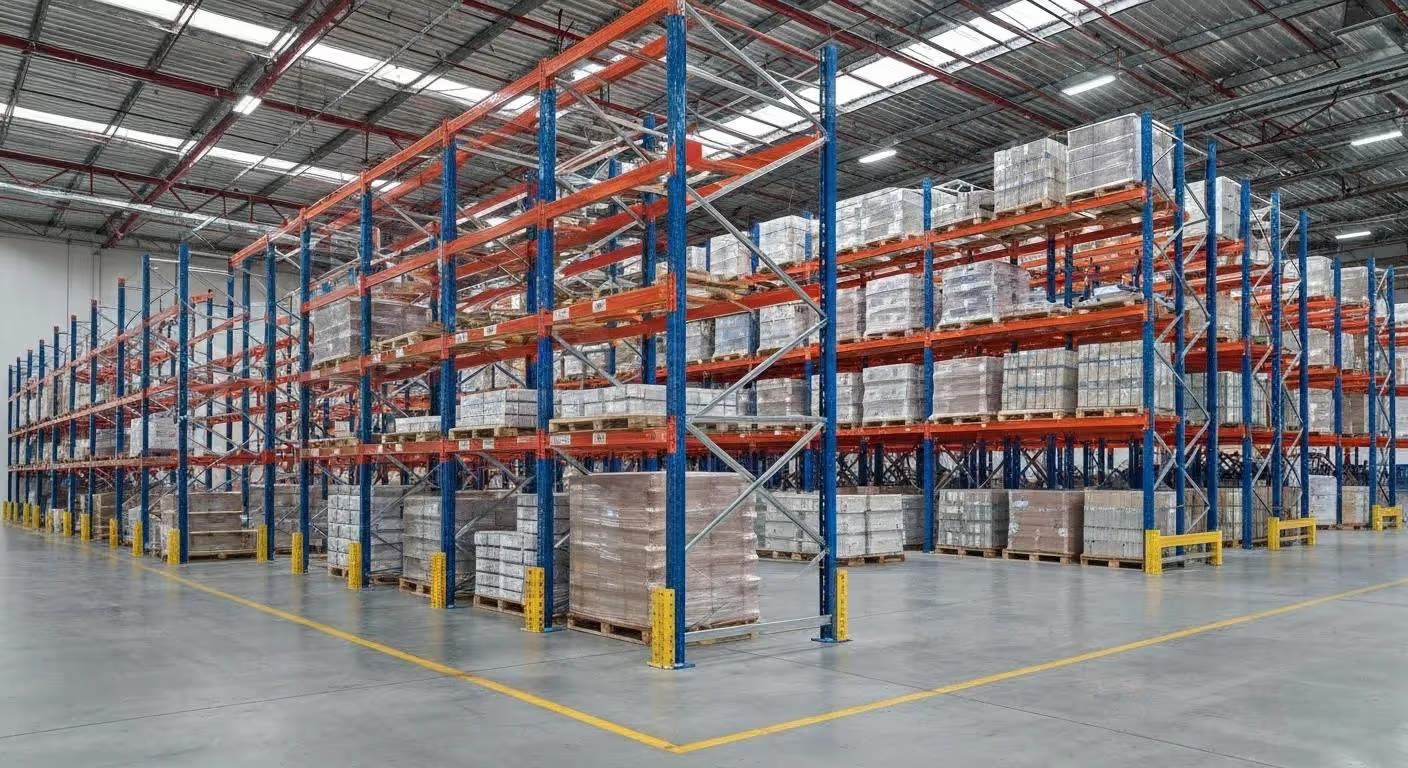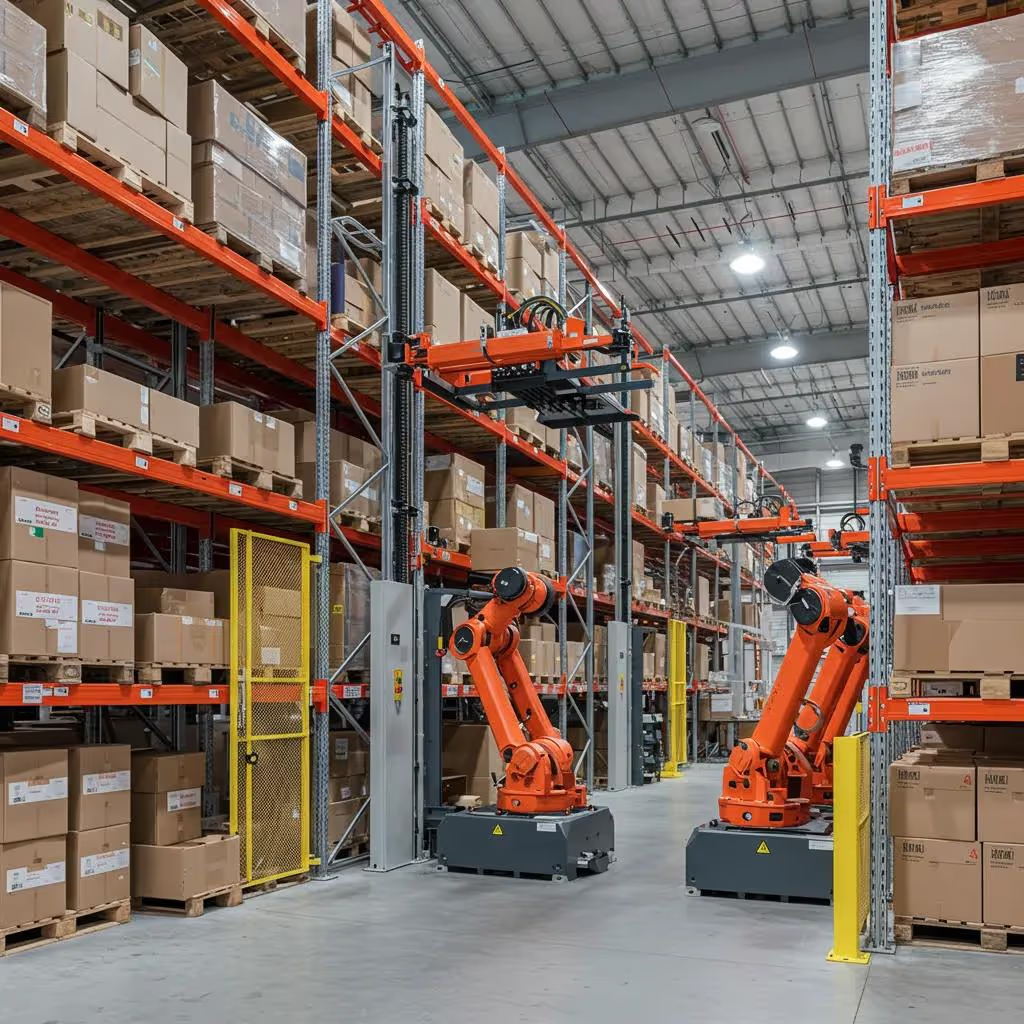
Efficient warehouse storage systems unlock tremendous gains in space utilisation and operational throughput, with studies showing poorly configured layouts can waste up to 30 percent of available floor and rack space. Today’s warehouses demand coordinated storage systems that integrate racking, shelving, automation and inventory control to resolve bottlenecks, reduce handling costs and boost accuracy. In this guide, you’ll discover:
- A clear definition of a warehouse storage system and its core benefits
- The main racking, shelving and automated solutions for every application
- How Warehouse Management Systems (WMS) integration drives real-time efficiency
- Proven selection criteria to match storage strategies to your products and budget
- Emerging trends in AI, IoT, robotics and sustainability shaping tomorrow’s facilities
By understanding these themes, you can optimise your material flow and explore how Skyteck Online’s tailored storage system designs deliver scalable, safe and cost-effective solutions.
What Is a Warehouse Storage System and Why Is It Essential?
A warehouse storage system is a coordinated arrangement of racks, shelves, conveyors and control software that maximises vertical and horizontal space and streamlines material flow for faster order fulfillment. By combining structural components and inventory management processes, storage systems reduce travel distances, increase throughput and lower carrying costs. For businesses facing rising labor expenses and space constraints, an efficient storage system delivers key improvements in capacity, safety and productivity.
Key reasons optimised storage matters include:
- Space optimisation through high-density layouts and multi-tier formats
- Operational efficiency driven by systematic slotting and picking paths
- Enhanced safety via sturdy racking, clear aisles and standardised handling
- Cost reduction from decreased labor time and minimised product damage
These foundational benefits set the stage for selecting the right combination of racking, shelving and automation that aligns with your throughput requirements and product characteristics.
How Do Warehouse Storage Systems Improve Space Optimisation?
Warehouse storage systems improve space optimisation by leveraging vertical cube, forming high-density lanes and modular components that adapt to changing inventory profiles. Raising pallet racks to the facility’s clear height and adopting narrow-aisle or multi-tier shelving multiplies storage capacity without expanding the footprint. Incorporating mobile shelving or dynamic flow lanes further compacts stock zones and eliminates under-utilised gaps.
- Vertical Cube Expansion – Extends storage upward, often reclaiming 50 percent more floor area
- Density Layouts – Uses drive-in, push-back or flow racking for continuous deep storage
- Modular Adaptability – Adjusts beam levels and shelf widths to match SKU dimensions
By combining these techniques, warehouses can typically improve usable space density by 30–60 percent, enabling facilities to handle greater volumes or reduce property costs.
What Are the Key Components of Warehouse Storage Systems?
A robust warehouse storage system relies on five interdependent components to function seamlessly: racking, shelving, automation, material handling equipment and inventory control software. Each element contributes a specific role:
- Racking – Steel frameworks supporting pallets and bulk containers
- Shelving – Unitised flow bays and compartment shelving for small parts
- Automation – AS/RS cranes, vertical lift modules and AGVs for hands-free retrieval
- Forklifts and Conveyors – Equipment that moves goods to and from storage points
- WMS Software – Real-time tracking, slotting algorithms and pick-path optimisation
Together, these components align physical storage with digital inventory data, creating a synchronised workflow that boosts accuracy, throughput and adaptability to seasonal demand variations.
How Does Efficient Storage Impact Warehouse Safety and Productivity?
Efficient storage systems enhance safety and productivity by establishing standardised storage locations, clear load capacities and well-defined material flow corridors. When racks and shelves are engineered to rated load specifications and integrated with WMS-guided pallet placement, the risk of collapse and product damage drops dramatically. Simultaneously, productivity climbs as workers navigate optimised aisles, pick routes and retrieval schedules rather than hunting for misplaced items.
Integrating rack protection, proper signage and automation interlocks promotes a safer environment while reducing injury-related downtime. As safety and speed improve in tandem, warehouses can handle higher order volumes with the same workforce, supporting scalable growth without compromising worker well-being.
What Are the Main Types of Warehouse Racking Systems?

Warehouse racking systems provide the structural backbone for palletised and bulk storage, each type offering distinct access rules, density levels and throughput capabilities. Selecting the right racking system hinges on load unit sizes, turnover rates and space constraints.
What Is Selective Pallet Racking and When Should It Be Used?
Selective pallet racking is the most common solution, offering direct forklift access to each pallet position and simple, modular design. Because each bay functions independently, this system maximises SKU accessibility and supports dynamic inventory rotation. It is ideal for operations with a wide variety of products, moderate to high pick frequencies and the need for full pallet selectivity.
Common benefits include:
- Unlimited selectivity for every pallet
- Easy reconfiguration by adjusting beam levels
- Low initial investment compared to automated systems
Selective racking’s flexibility paves the way for more specialised high-density solutions when SKU profiles and throughput requirements evolve.
How Do Drive-In and Drive-Through Racking Systems Work?
Drive-in and drive-through racking systems increase storage density by grouping pallets in deep lanes served by forklifts that enter the rack structure.

These systems eliminate multiple aisles in favor of deeper lanes. Drive-in prioritises last-in, first-out (LIFO), while drive-through supports FIFO requirements for perishable or regulated goods. Both formats reclaim valuable floor space but require precise load uniformity and forklift operator training.
What Are the Benefits of Push-Back and Pallet Flow Racking?
Push-back and pallet flow racking optimise density with dynamic storage lanes that improve retrieval speed:
- Push-Back Racking uses nested carts on inclined rails that allow successive pallets to “push” previous loads backward.
- Pallet Flow Racking relies on gravity rollers for continuous first-in, first-out retrieval.
Key advantages include:
- 30–40 percent higher density than selective systems
- FIFO or LIFO flexibility for product rotation
- Improved ergonomics by minimising forklift travel
These high-density configurations support rapid replenishment and accurate stock rotation while retaining controlled access and better selectivity than drive-in lanes.
When Is Cantilever Racking Ideal for Warehouse Storage?
Cantilever racking excels at handling long or irregular loads such as lumber, piping and rolled products by providing unobstructed horizontal support. Its bracket-style arms extend from upright columns, accommodating variable lengths and weights without front rack posts impeding forklift entry.
Cantilever racking is essential when storing:
- Long building materials up to 30 feet in length
- Sheet goods and flat panel inventory
- Structural steel and fabrications
By matching bracket capacity and arm length to product specifications, facilities gain a high throughput solution for dimensional goods that traditional pallet racks cannot accommodate.
How Do Shelving Systems Enhance Industrial Storage Solutions?
Shelving systems organise small parts, tools and lightweight goods in compact footprint areas, enabling efficient pick and replenishment workflows. Unlike pallet racks, shelving units focus on carton-level storage and order consolidation.
What Are the Differences Between Static and Mobile Shelving?

How Does Industrial Shelving Support Warehouse Operations?
Industrial shelving supports operations by segmenting SKUs into logical zones, improving picking accuracy and reducing travel times. By combining bin dividers, label holders and WMS-driven slotting rules, shelving systems deliver organised batch picking and wave fulfillment. Small-parts drawers and shelf trays further refine access, enabling workers to locate components in seconds rather than minutes.
Through optimised shelf height, compartment sizing and picking path design, warehouse managers can boost order throughput by over 25 percent while maintaining error rates below 1 percent.
What Are the Best Practices for Designing Shelving Layouts?
Effective shelving layouts balance accessibility, density and ergonomics based on SKU characteristics and order profiles. To design an optimised shelving plan:
- Analyse SKU dimensions, weight and pick frequency for slotting priority.
- Maintain aisle widths of 36–48 inches for safe manual picking.
- Group high-velocity SKUs near packing stations to reduce travel.
- Use adjustable shelf heights to eliminate wasted vertical space.
Applying these guidelines ensures that shelving zones operate at peak productivity and integrate smoothly with adjacent racking and conveyor networks.
What Are Automated Warehouse Storage Solutions and Their Benefits?

Automated warehouse storage solutions deploy robotics and mechatronics to handle repetitive tasks, dramatically improving throughput, accuracy and safety. By replacing manual retrieval with AS/RS cranes, vertical lift modules and autonomous mobile robots, facilities achieve 99 percent inventory accuracy and up to 50 percent higher cube utilisation.
How Do Automated Storage and Retrieval Systems (AS/RS) Improve Efficiency?
AS/RS platforms use robotic shuttles or cranes running along dedicated aisles to pick and place pallets or totes with pinpoint precision. These systems minimise aisle space, operate continuously and eliminate human error in high-throughput environments.
Primary efficiency gains include:
- Throughput increases of 200 percent during peak operations
- Space utilisation improvements of 40 percent by narrowing aisles
- Error reduction to under 0.1 percent through automated verification
By combining AS/RS with WMS slotting algorithms, Skyteck Online’s installations deliver seamless end-to-end automation from order receipt to shipping dock.
What Roles Do Vertical Lift Modules (VLMs) Play in Automation?
Vertical Lift Modules utilise enclosed columns of trays that automatically shuttle to an operator at ergonomic pick windows. These high-density, footprint-efficient machines support carton-level storage with built-in pick-to-light guidance.
- 85 percent space savings over traditional shelving
- Productivity boosts of 3–5 picks per minute
- Improved inventory security via controlled tray access
VLMs excel for small-parts kitting and high-velocity picking domains, integrating seamlessly with existing conveyors and goods-to-person cells.
Research indicates that Vertical Lift Modules (VLMs) are a form of automated storage and retrieval system (ASRS) capable of substantially enhancing warehouse efficiency by reducing travel time and optimising storage density, especially for small items.
Automated Vertical Lift Modules (VLMs) for Warehouse Storage
Vertical Lift Modules (VLMs) in warehouses utilise automated systems and software to deliver goods to the operator. VLMs are a form of automated storage and retrieval system (ASRS) capable of substantially enhancing warehouse efficiency by reducing travel time and optimising storage density. This benefit is especially pronounced for small items such as bolts and screws.A matheuristics for the configuration of automated vertical lift modules warehouses, G Tresca, 2024
How Are Automated Guided Vehicles (AGVs) and Autonomous Mobile Robots (AMRs) Integrated?
AGVs and AMRs transport pallets, carts and totes between storage zones, packing stations and staging areas using pre-programmed routes or AI-driven path planning. These systems free personnel from non-value-added travel and support continuous material flow.
- Dock-to-dock route mapping aligned with storage locations
- WMS communication for dynamic task assignment
- Safety sensors and LIDAR for obstacle detection
Through synchronised task orchestration, AGVs and AMRs reduce forklift traffic, lower CO₂ emissions and enable 24/7 operations without additional labor.
The integration of Robotic Mobile Fulfillment Systems (RMFS) is a key strategy for reducing labor costs and enhancing picking efficiency in high-density storage warehouses with spatial constraints.
Robotic Mobile Fulfillment Systems in High-Density Warehousing
This research examines a Robotic Mobile Fulfillment System (RMFS) deployed in high-density storage warehouses characterised by spatial constraints. The primary objectives are to reduce labor costs and enhance picking efficiency. An RMFS is defined as a category of automated storage and retrieval systems that employ mobile robots for the storage and retrieval of goods.A simulation study on the robotic mobile fulfillment system in high-density storage warehouses, M Qi, 2021
What Are the Challenges and Solutions for Automation Integration?
Automation integration presents challenges such as high capital expenditure, system interoperability and change management. These obstacles can be overcome by:
- Conducting a phased ROI analysis to justify upfront investment.
- Selecting open-architecture controls compatible with existing WMS/WES.
- Providing operator training and process documentation.
- Partnering with experienced integrators for turnkey commissioning.
By applying these solutions, organisations realise payback periods of 18–36 months and transition smoothly to automated workflows.
How Does Integration with Warehouse Management Systems (WMS) Optimise Storage?
Integrating physical storage systems with a robust Warehouse Management System ensures real-time visibility, guided slotting and automated task sequencing that aligns racks, shelves and robotics into a unified flow. This synergy transforms disparate storage assets into an intelligent network that responds dynamically to demand fluctuations.
What Is the Role of WMS in Real-Time Inventory Management?
A WMS tracks every unit in the facility from receipt to dispatch, updating stock levels instantly and generating alerts for replenishment or relocation. By maintaining accurate digital twins of pallet positions and bin contents, the WMS enables just-in-time restocking, picks consolidation and capacity forecasting.
Real-time inventory control helps avoid stockouts, reduce safety stock and support lean supply chain strategies.
Systematic literature reviews highlight that the effective integration and optimisation of Warehouse Management Systems (WMS), particularly concerning the Storage Location Allocation Problem (SLAP), are important for enhancing warehouse logistics.
Optimising Warehouse Management Systems (WMS) for Efficient Storage
Warehouse Management Systems (WMS) can enhance warehouse logistics through the integration and optimisation of WMS functionalities. This paper presents a systematic literature review focused on the effective integration and optimisation of Warehouse Management Systems (WMS). The Storage Location Allocation Problem (SLAP) is an important consideration for optimising storage.The effective integration and optimisation of Warehouse Management Systems: A Systematic Literature Review, Unknown Author, 2024
How Does WMS Enhance Warehouse Storage System Performance?
WMS platforms enhance storage system performance by optimising slotting, wave picking and put-away logic based on product velocity and storage density requirements. Algorithm-driven recommendations adjust pallet locations to balance load across aisles, while pick-to-light and voice guidance cut travel times.
Key performance improvements include:
- 20–30 percent reduction in total travel distance
- 15–25 percent increase in pick-line productivity
- Automated replenishment to maintain optimal pick face levels
This level of orchestration ensures that storage infrastructure operates at peak efficiency under varying demand scenarios.
What Are the Benefits of Combining Physical Storage with WMS/WES?
Combining racks, shelving and automation with Warehouse Execution Systems creates an end-to-end choreography of inbound receiving, storage allocation, order picking and outbound staging. Benefits of this holistic approach include:
- Predictive replenishment that aligns put-away with upcoming picks
- Balanced workload distribution across robots and operators
- Real-time KPI dashboards tracking throughput and utilisation
- Reduced manual intervention and error rates under 0.5 percent
This cohesive solution supports continuous improvement and rapid scalability as volumes grow.
How to Choose the Right Warehouse Storage System for Your Business?
Selecting the ideal storage system requires careful assessment of product mix, throughput targets, space constraints and budgetary parameters. A structured decision process ensures your investment delivers maximum ROI and operational agility.
What Factors Should Influence Your Storage System Selection?
When evaluating options, consider these key factors:
- SKU dimensions and weight categories
- Daily throughput and peak order volumes
- Available building height and bay widths
- Capital expenditure versus long-term operating costs
- Labor availability and skill levels
Balancing these factors guides the choice between selective racking, high-density solutions or full automation.
How Does Product Type Affect Storage System Choice?
Product characteristics dictate system compatibility:
- Uniform pallet loads suit drive-in, flow or push-back racks
- Irregular long goods require cantilever or bulk storage
- Small, high-velocity parts benefit from shelving, VLMs or pick modules
Matching storage geometry to product form and turnover profile optimises handling and minimises rework.
What Is the Impact of Automation Level and Throughput Requirements?
Automation level correlates with throughput demands and budget:
- Manual operations remain cost-effective under 500 picks per day
- Semi-automated conveyors and pick-to-light systems fit mid-range volumes
- Fully automated AS/RS and robotics become viable above 5,000 picks per day
Assessing break-even points for each technology ensures investments align with growth projections.
How Can ROI and Cost Reduction Be Evaluated?
ROI evaluations should include:
- Space cost savings from higher density layouts
- Labor cost reductions via automation and optimised workflows
- Shrinkage decreases through better inventory control
- Throughput gains measured in orders per labor hour
Comprehensive modeling that factors capital, operating and maintenance costs provides a clear financial justification for any storage system upgrade.
What Are the Future Trends and Innovations in Warehouse Storage Systems?
Looking ahead, warehouse storage systems will evolve through deeper AI integration, IoT-driven analytics, robotics and sustainable design, ushering in a new era of intelligent, eco-efficient logistics.
How Will AI, IoT, and Robotics Transform Warehouse Storage?
Artificial intelligence will enable self-optimising slotting and predictive maintenance, while IoT sensors will monitor rack loads, temperature and product condition in real time. Advanced robotics including swarm-based AMRs and drone-assisted inventory audits will further automate routine tasks. Together, these technologies will create highly adaptive storage networks that respond instantaneously to demand shifts.
What Is the Growing Importance of Sustainability in Storage Solutions?
Sustainability initiatives drive demand for energy-efficient lighting, low-VOC coatings and recyclable rack materials. Solar-equipped rooftops and regenerative braking on cranes reduce carbon footprints. Lifecycle analyses of storage assets guide procurement toward eco-friendly designs, aligning warehouse operations with corporate responsibility goals.
How Are Industry-Specific Storage Needs Shaping New Solutions?
Specific sectors are spawning tailored configurations: cold storage racking with insulated frames for perishables, explosive-proof shelving for chemical warehouses and anti-microbial coatings for pharmaceutical environments. E-commerce facilities are adopting high-rise mezzanines and robotic shuttle systems to handle diverse SKUs in constrained footprints.
What Market Growth and Automation Statistics Should Businesses Know?
Key industry benchmarks to guide strategic planning:
- Global warehousing and storage market projected to exceed $1.17 trillion by 2025
- Warehouse automation market set to grow at a 16.2 percent CAGR through 2030
- Over 4 million warehouse robots expected in service by 2025
- More than 90 percent of modern warehouses now use WMS or WES platforms
These figures underscore the accelerating shift toward intelligent, integrated storage systems that combine structural, digital and robotic capabilities.
Skyteck Online’s expertise in designing, supplying and commissioning tailored storage systems ensures your facility leverages these trends to stay competitive and future-ready.
Contact Skyteck Online to explore a customised storage solution that aligns with your operational goals, space constraints and sustainability targets. Our team will help you evaluate options, model ROI and implement a seamless transition to an optimised warehouse environment.


.svg)






